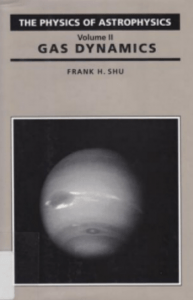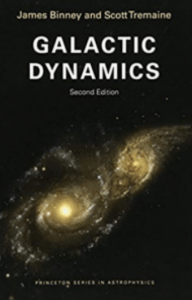This course presents an in-depth treatment of the dynamics of astrophysical systems, including gases, plasmas, and stellar systems. The course starts with a detailed formulation of the theoretical foundations, using kinetic theory and statistical physics to describe the dynamics of many-body systems. Special emphasis will be given to collisional processes in various astrophysical systems. Next, after deriving the relevant moment equations, we focus on specific topics related to (i) stellar dynamics, (ii) hydrodynamics, and (iii) plasma physics. Related to stellar dynamics we cover potential theory, orbit theory, Jeans modeling, gravitational encounters and secular evolution (bars and spiral structure). In the field of (non-radiative) hydro- dynamics we study, among others, the Navier-Stokes equation, vorticity, transport coefficients, accretion flow, turbulence, fluid instabilities, and shocks. We end with a cursory overview of plasma physics, including the Vlasov equation and the two-fluid model, Langmuir waves, Alfvén waves, Landau damping, ideal vs. resistive magneto- hydrodynamics (MHD), and dynamos. Throughout the course we shall focus on specific astrophysical applications.
Lecture hours: TTh 9-10.15am, classroom KT 221 (Kline Tower)
Office hours: by appointment only (office KT#649)
Syllabus: Click here for download
Lecture Notes: PDF document (347 pages). Click here for download. NOTE: lecture notes will be updated throughout the semester. Check back regularly for updates.
Grading:
- 35% final exam (oral)
- 35% problem sets
- 30% midterm exam (written)
For more information, use the Yale Canvas System.
Textbook(s)
Although no textbook is required (detailed lecture notes will be made available), there are several excellent textbooks that are recommended for this course. Some of those textbooks are listed below (see lecture notes for a more extensive list).
Lecture Slides
Most lectures used the blackboard, but for several lectures I prepared slides. These are available here as PDFs for download.
- Lecture 1 (8.31) Introduction & big-picture overview I
- Lecture 2 (9.05) Introduction & big-picture overview II
- Lecture 3 (9.07) Hamiltonian Dynamics & Hamilton-Jacobi Theory
- Lecture 4 (9.12) Action-Angle variables
- Lecture 5 (9.14) Kinetic Theory I. No slides available [see Chapter 5 of lecture notes]
- Lecture 6 (9.19) Kinetic Theory II.
- Lecture 7 (9.21) Stochasticity & the Langevin equation
- Lecture 8 (9.26) The Fokker-Planck equation
- Lecture 18 (11.07) Jeans Modeling (Part I)
- Lecture 19 (11.09) Jeans Modeling (Part II)
- Lecture 24 (12.07) Magnetohydrodynamics
Problem Sets
Problem sets (and their solutions) will be made available for download here.
- Problem Set 1: due September 12
- Problem Set 2: due September 21
- Problem Set 3: due October 17
- Problem Set 4: Not yet available
- Problem Set 5: Not yet available
NOTE: Don’t forget to indicate your name, staple your work, and always explain your answers to the problem sets. Points will be subtracted if you fail to explain how you came to the solution, even if it is correct.
Preliminary Schedule
PART I: Theoretical Foundations [Lectures 1-5]
❖ Time and length scales of astro-physical many-body systems
❖ Review of Classical Dynamics:
Lagrangian & Hamiltonian formalism, Poisson brackets, canonical transformations
❖ Kinetic Theory:
Liouville theorem, BBGKY hierarchy, Boltzmann and Vlasov equations
❖ Collisional Dynamics:
Langevin equation, fluctuation-dissipation theorem, relaxation time, Lenard-Balescu equation, diffusion coefficients, Fokker-Planck equation, Maxwell-Boltzmann distribution
PART II: Stellar Dynamics [Lectures 6-12]
❖ Potential Theory
Poisson equation, spherical systems, ellipsoidal systems, multipole expansion, disk potentials
❖ Orbit Theory
integrals of motion, action-angle variables, KAM theorem, surfaces of section, resonances
❖ Jeans Theorem & Jeans Modeling
Jeans equations of spherical, axisymmetric & triaxial systems, mass-anisotropy degeneracy kinematics, Schwarzschild modeling
❖ Gravitational Encounters & Relaxation
impulse approximation, dynamical friction, orbital decay, phase mixing, violent relaxation
PART III: Hydro Dynamics [Lectures 13-20]
❖ Equations of Hydrodynamics
continuity, momentum and energy equations, closure relations (equations of state)
❖ Vorticity & Circulation
vortex tubes, vorticity equation, baroclinicity, Helmholtz theorems, turbulence
❖ Transport Coefficients
Chapman-Enskog expansion, diffusion, viscosity & thermal conductivity, stress tensor
❖ Navier-Stokes
viscous flow, accretion flow
❖ Fluid Instabilities
Kelvin-Helmholtz, Rayleigh Taylor, convective instability, thermal instability, Jeans criterion
❖ Sound waves & Shocks
linear perturbation theory, sound speed, Rankine-Hugoniot jump conditions
PART IV: Plasma Physics [Lectures 21-24]
❖ Introduction to Plasmas
length scales, Debye length, plasma frequency, plasma parameter, collision frequency
❖ Plasma Orbit Theory
gradient drift, curvature drift, polarization drift, magnetic mirrors
❖ Collisionless Plasmas
Vlasov equation, Langmuir waves, Landau damping, two-fluid model
❖ MagnetoHydroDynamics (MHD)
resistive vs. ideal MHD, Ohms’ law, induction equation, dynamos







